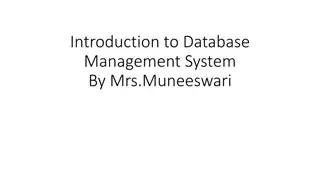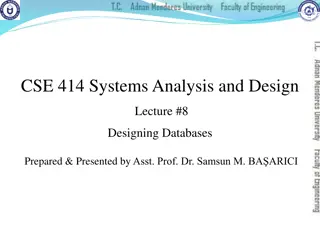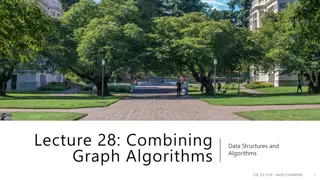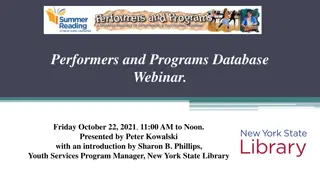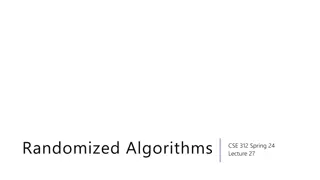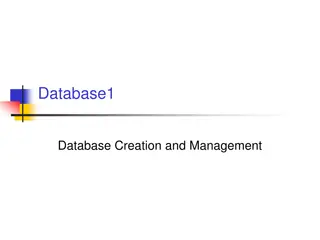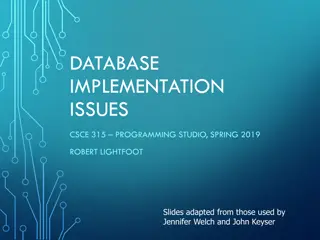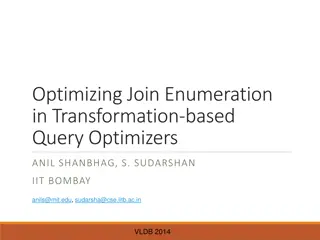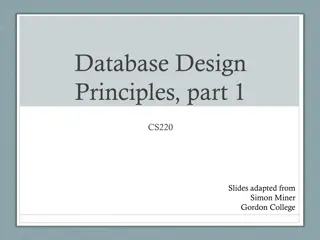Join Algorithms in Database Management
In database management, various join algorithms are utilized to optimize query processing, including Nested-Loop Join, Index Join, Sort-Merge Join, and Hash Join. Each algorithm has its own methodology and benefits, ultimately aiming to efficiently combine data from different tables based on specific join conditions. Understanding these join algorithms is crucial for database developers and administrators to enhance query performance and overall system efficiency.
Download Presentation

Please find below an Image/Link to download the presentation.
The content on the website is provided AS IS for your information and personal use only. It may not be sold, licensed, or shared on other websites without obtaining consent from the author.If you encounter any issues during the download, it is possible that the publisher has removed the file from their server.
You are allowed to download the files provided on this website for personal or commercial use, subject to the condition that they are used lawfully. All files are the property of their respective owners.
The content on the website is provided AS IS for your information and personal use only. It may not be sold, licensed, or shared on other websites without obtaining consent from the author.
E N D
Presentation Transcript
CS143: Joins Professor Junghoo John Cho
Motivation Q: How do we process SELECT * FROM Student WHERE sid > 30? Q: How do we process SELECT * FROM Student S, Enroll E WHERE S.sid = E.sid?
? ? ? A A S R 10 60 40 20 T6 T7 T8 T9 40 60 30 10 20 T1 T2 T3 T4 T5 3
Four Join Algorithms Nested-Loop Join (NLJ) Index Join (IJ) Sort-Merge Join (SMJ) Hash Join (HJ)
Nested-Loop Join (NLJ) For each r R: For each s S: if r.A = s.A, then output (r,s) S R 10 60 40 20 T6 T7 T8 T9 40 60 30 10 20 T1 T2 T3 T4 T5 5
Index Join (IJ) (1) Create an index for S.A if needed (2) For each r R: X := lookup index on S.A with r.A value For each s X, output (r,s) R 40 T1 S 60 T2 30 T3 10 T6 10 T4 60 T7 20 T5 40 T8 20 T9 6
Sort-Merge Join (SMJ) Sort the relations first, then join R S 10 20 40 60 T6 T9 T8 T7 10 20 30 40 60 T4 T5 T3 T1 T2 7
Sort-Merge Join (SMJ) (1) if not, sort R and S by A (2) i 1; j 1; while (i |R|) (j |S|): if (R[i].A = S[j].A) then output (R[i], S[j]); i i+1; j j+1; else if (R[i].A > S[j].A) then j j+1 else if (R[i].A < S[j].A) then i i+1 S R 10 20 40 60 T6 T9 T8 T7 10 20 30 40 60 T4 T5 T3 T1 T2 8
Hash Join (HJ) Hash function: h(v) [1, k] Q: Given (r R) and (s S), can r and s join if h(r.A) h(s.A)? Main idea Partition tuples in R and S based on hash values on join attributes Perform joins only between partitions of the same hash value
Hash Join (HJ) H(k) = k mod 3 S R 0 0 1 1 2 2 10 60 40 20 T6 T7 T8 T9 40 60 30 10 20 T1 T2 T3 T4 T5 10
Hash Join (HJ) Hash function: h(v) [1, k] (1) Hashing stage (bucketizing): hash tuples into buckets Hash R tuples into G1, ,Gk buckets Hash S tuples into H1, ,Hk buckets (2) Join stage: join tuples in matching buckets For i = 1 to k do match tuples in Gi, Hi buckets S R G1 H1 G2 H2 G3 H3 11
Comparison of Join Algorithms Q: Which algorithm is better? Q: What does better mean? Ultimate bottom line: Which algorithm is the fastest ? Q: How does the system know which algorithm runs fast? Run all join algorithms and pick the fastest one?
Cost Model A model to estimate the performance of a join algorithm Multiple cost models are possible depending on their sophistication Our cost model: # disk blocks that are read/written during join Not perfect: ignores random vs sequential IO differnce, CPU cost, But simple to analyze And good enough to pick the best join algorithm Cost of join is dominated by disk IO Most join algorithms have similar disk access pattern Our cost model ignores the last IO for writing the final result This cost is the same for all algorithms
Running Example Join two tables: R S |R| = 1,000 tuples, |S| = 10,000 tuples ??= 100 blocks, ?? = 1,000 blocks (10 tuples/block) M = main memory cache 22 disk blocks Memory 10 tuples . . . R (100 blocks) . . . S (1000 blocks) . . . . . . 22 blocks
Cost of Join Algorithms Formula (??< ??) Cost NLJ SMJ HJ IJ
Sort-Merge Join (SMJ) (1) if not, sort R and S by A (2) i 1; j 1; while (i |R|) (j |S|): if (R[i].A = S[j].A) then output (R[i], S[j]); i i+1; j j+1; else if (R[i].A > S[j].A) then j j+1 else if (R[i].A < S[j].A) then i i+1 S R 10 20 40 60 T6 T9 T8 T7 10 20 30 40 60 T4 T5 T3 T1 T2 16
Cost of Join Stage of Sort-Merge Join M = 22 . . . R (100 blocks) S (1000 blocks) . . . Q: Ignoring the final write of output, how many disk blocks are read during join? Q: We only used 3 memory blocks. Can we use the rest to make things better?
What About? Q: Will this lead to fewer disk block reads? M = 22 10 tuples 10 blocks . . . R (100 blocks) ... 10 blocks S (1000 blocks) . . . ...
Cost of Join Algorithms Cost (M=22, ?? =100, ??=1000) Formula (??< ??) NLJ SMJ HJ IJ
Nested-Loop Join (NLJ): R S For each r R: For each s S: if r.A = s.A, then output (r,s) M = 22 . . . R (100 blocks) S (1000 blocks) . . . Scan S table once for every tuple of R 20
Nested Loop Join Scan S table once for every tuple of R M = 22 10 tuples . . . R (100 blocks) S (1000 blocks) . . . Q: Can we do better?
Block Nested Loop Join Scan S table once for every block of R M = 22 10 tuples . . . R (100 blocks) S (1000 blocks) . . . Q: Can we do even better? What is the maximum # of blocks that we can read in one batch from R?
Block Nested Loop Join Scan S table once for every 20blocks of R M = 22 20 blocks 10 tuples . . . R (100 blocks) ... S (1000 blocks) . . . Q: What if we read S first?
Block Nested Loop Join Scan R table once for every 20 blocks of S M = 22 20 blocks 10 tuples S (1000 blocks) . . . ... . . . R (100 blocks)
Cost of Join Algorithms Cost (M=22, ?? =100, ??=1000) Formula (??< ??) NLJ SMJ HJ IJ
Nested Loop Join Summary Always use block nested loop join (not the na ve algorithm) Read as many blocks as possible for the left table in one iteration Use the smaller table on the left (i.e., outer loop)
Hash Join (HJ) Step (1): Hashing stage: h(v) [1, k] buckets Memory G1 G2 R ... ... Gk Step (2): Join stage Memory S R H1 H2 G1 G2 G3 ... Gi Hi ... 27
HJ: Bucketizing Stage Read R table and hash them into k buckets M = 22 . . . G1 . . . G2 . . . R (100 blocks) . . . Gk Q: Given M=22, what is the maximum k? Q: How many disk IOs to bucketize R?
HJ: Bucketizing Stage Read S table and hash them into k buckets M = 22 . . . H1 . . . H2 . . . S (1000 blocks) . . . Hk Q: In general, what is the cost for bucketizing R and S?
HJ: Join Stage Join tuples in Gi with those in Hi 48 blocks M = 22 5 blocks . . . . . . H1 G1 . . . . . . H2 G2 . . . . . . Hk Gk Q: How can we join tuples in G1 with H1? How should we use memory?
Cost of Join Algorithms Cost (M=22, ?? =100, ??=1000) Formula (??< ??) NLJ SMJ HJ IJ
HJ: Join Stage Q: What if R is large, say ??= 1000, and Gi > 20? 48 blocks 48 blocks M = 22 . . . G1 H1 . . . . . . G2 H2 . . . . . . Hk Gk . . . A: Exactly the same as standard join problem. Apply hash join algorithm to join H1 and G1 Apply hash join algorithm using a new hash function!
HJ: Recursive Partitioning Use a new hash function h (v) [1, k] to recursively partition Gi and Hi to even smaller partitions (until one of them fit in main memory) ?? ? 2 # of bucketizing steps needed for R: logM 1 In each bucketing steps, we perform 2(??+ ??) disk IOs
Cost of Join Algorithms Cost (M=22, ?? =100, ??=1000) Formula (??< ??) NLJ SMJ HJ IJ
Index Join (IJ): R S For each r R: X := lookup index on S.A with r.A value For each s X, output (r,s) M = 22 . . . R (100 blocks) . . . S (1000 blocks) . . . Cost = IOs for (R scan + index look up + tuple read from S) 35
IJ Example (1) 15 blocks for index 1 root 14 leaf On average, 1 matching S tuple per an R tuple Q: How many disk IOs? How should we use the memory? M = 22 . . . R (100 blocks) 1 block 14 blocks . . . . . . S (1000 blocks) . . .
IJ Example (1) Cost for R scan: Cost for Index look up: Cost for read matching S tuple: M = 22 . . . R (100 blocks) 1 block 14 blocks . . . . . . S (1000 blocks) . . .
IJ Example (2) 40 blocks for index 1 root 39 leaf On average, 10 matching S tuple per an R tuple Q: How many disk IOs? How should we use the memory? M = 22 . . . R (100 blocks) 1 block . . . . . . 39 block 18 blocks S (1000 blocks) . . .
IJ Example (2) Cost for R scan: Cost for Index look up: Cost for read matching S tuple: M = 22 . . . R (100 blocks) 1 block . . . . . . 18 blocks S (1000 blocks) . . .
Cost of Join Algorithms Cost (M=22, ?? =100, ??=1000) Formula (??< ??) NLJ SMJ HJ IJ
SMJ: Cost of Sorting Sort-Merge Join 1. Sort stage: Sort R and S 2. Join stage: Join sorted R and S Q: How many disk IOs during sort stage?
SMJ: Cost of Sorting Q: How can we sort R? Sorted runs . . . . . . . . . . . . . . . R (100 blocks) . . . M = 22 Q: How many blocks can we sort in each batch? Do we need to allocate one block for output? Q: How many sorted runs?
SMJ: Cost of Sorting Q: What to do with sorted runs? Sorted runs . . . . . . . . . . . . M = 22 Q: How many disk IOs during the merge step of sort? Q: Total IOs for sorting R?
SMJ: Cost of Sorting Q: How can we sort S? Sorted runs . . . . . . . . . . . . . . . S (1000 blocks) . . . M = 22 Q: How many sorted runs are produced from S?
SMJ: Cost of Sorting Q: How many sorted runs can we merge at a time? Sorted runs . . . . . . . . . . . . . . . . . . M = 22 Q: What to do with the produced sorted runs?
SMJ: Cost of Sorting Q: How many merging steps are needed to sort S? 1 initial sorting 2 merging steps of sorted runs 2,000 disk IO s per each sorting/merging step 6,000 total disk IO s to sort S table In general, to sort R of ?? blocks with M memory buffers, we need 1 initial sorting log? 1(?? 2 ??disk IO s per each sorting/merging stage In total, 2?? ?) subsequent merging stages log? 1(?? ?) + 1disk IO s are needed
Cost of Join Algorithms Cost (M=22, ?? =100, ??=1000) Formula (??< ??) NLJ SMJ HJ IJ
Cost of Join Algorithms Cost (M=22, ?? =100, ??=1000) Formula (??< ??) ?? ? 2?? log? 1(?? log? 1(?? ??+ NLJ 5,100 2?? ?) + 1 + ?) + 1 +(??+??) 7,500 (if unsorted) 1,100 (if sorted) SMJ 2?? ?? ? 2+ (??+??) 2(??+??) logM 1 HJ 3,300 ??+ |?|(? + ?) IJ 1,115 10,640 C: index lookup cost, J: # matching S tuples per R tuple
Summary of Joins Nested-loop join is OK for small relations (relative to memory size) Hash join is usually the best for equi-join If tables have not been sorted and with no index Consider merge join if tables have been sorted Consider index join if index exists To pick the best, DBMS needs to maintain data statistics
Query Optimization R(A, B) S(B,C) T (C,D): SELECT * FROM R, S, T WHERE R.B = S.B AND S.C = T.C AND R.A = 10 and T.D < 30 Q: How can we process the above query? ??.?<30 ??.?=10 ??.?=10 ??.?=10 ??.?<30 ??.?<30 R S T T S R R S T




